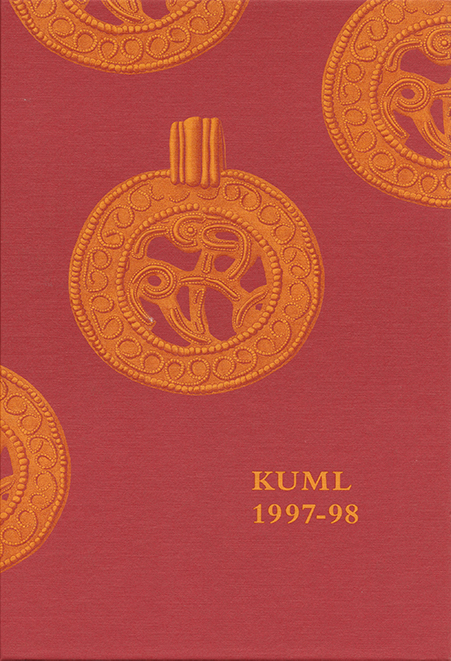A Harness Cheek-piece from Bøgeskov Strand
DOI:
https://doi.org/10.7146/kuml.v41i41.113367Keywords:
Harness cheek-piece, bøgeskov strand, randers, late Viking ageAbstract
A Harness Cheek-piece from Bøgeskov Strand
In December 1994 the National Museum in Copenhagen received an unusual object made of copper alloy and resembling two horse's heads facing each other. It was found on the beach below a steep slope of clay at Bøgeskov, south of the old entrance to Rands Fjord, where the coast is exposed to erosion by Vejle Fjord (fig. 1).
The thin copper alloy plate measures 9.7 cm x 4.2 cm (fig. 2). A small part is missing and the surface is very worn, but the ornament on one side is still visible. The plate functioned as a decorative cheek-piece for a horse-bit, one of a pair.
Similar cheek-pieces are known from several Danish finds. One of the best preserved pieces is from Dueholm Mark on Mors (fig. 3.1). The eye for the harness strap is intact and one of the animal heads as well as the fine contours stand out clearly. This cheek-piece and a fragment of a Viking Age sword came to the National Museum in 1925. The two objects had been found close to a burial mound and may have come from destroyed burials or a possible settlement site nearby. Graves containing riding equipment and weapons are well-known in the western Limfjord area, and an equestrian burial came to light in 1857 on Dueholm Mark, but unfortunately this find was not preserved.
Excavation or detector scanning on known settlement sites have revealed other fragments of cheek-pieces in Denmark, and a further example is known from Skåne. All are broken, and the fragments can be difficult to identify. The breaks typically occur down the centre of the cheek-piece or across the middle.
No intact cheek-pieces have as yet been found in Denmark, but a well-preserved pair came to light during turf digging in a bog 40-50 metres south of Leck River between Leck and Kokkedal in 1921 (fig. 4). The animal figures on this pair have a more rounded cross section than those on the cheek-piece from Bøgeskov Strand. They mirror each other, and each cheek-piece depicts a single animal, i.e. the head with a large eye and open jaws opposite the tail end.
The cheek-pieces from Leck and similar objects from England are single finds, but complete horse bits with copper alloy cheekpieces are known from burials in Norway and Sweden. They confirm that the cast cheek-pieces were combined with iron bits. A few very stylized cheek-pieces were made of iron alone.
A horse-bit with copper alloy cheekpieces and a two-link iron bit from Lundby, Södermanland in Sweden, corresponds very closely to the set from Leck (fig. 5). It was found in a cremation burial together with a pair of decorated copper alloy stirrups, a pair of copper alloy spurs, an iron spearhead, a knife, a rivet and a few corroded iron fragments. Another well-preserved horse-bit from Årsunda grave III, Gästrikland in Sweden, was found with strap mounts similar to those from Leck and Lundby, as well as cross-shaped mounts. The cheek-pieces from Årsunda and a Norwegian example from Vestby near Oslo in Norway have a flat cross section similar to the one from Bøgeskov Strand. The horse-bit from Vestby was found in 1862 together with an iron spearhead, a small knife and a copper alloy ornament close to the site of a burial mound, and the objects probably represent a destroyed burial.
The cheek-piece from Dueholm Mark is in the Ringerike style which appeared in Scandinavia at the end of the 10th century and continued in use through the first half of the 11th century. Characteristic are the flared terminals of the mane and tail as well as the round eyes. The cheek-pieces from Leck in Schleswig and Lundby in Sweden as well as the fragment from Sønderholm (fig. 3.5) are slightly different but still have Ringerike traits. Other pieces are closer to the later Urnes style. The cheek-piece from Bøgeskov Strand and other Danish finds may be dated to the first half and middle of the 11th century, a date which is not contradicted by other datable objects present in the Swedish burials containing similar horsebits.
The horse-bits with copper alloy cheekpieces are very different from the horse-bits in the Danish equestrian burials of the 10th century. These earlier bits were made entirely of iron with long cheek-bars and cheekplates which might be decorated with silver. The bits are often found together with tall, triangular stirrups decorated with silver and copper. This type of stirrup was followed by stirrups with a short triangular or semi-circular hoop. Examples of the latter type made of copper alloy are rare but have, unlike the horse-bits, long been known in Denmark.
The custom of depositing weapons and riding equipment in burials continued after 1000 AD in Norway and Sweden, but came to an end in Denmark, and horse-bits with copper alloy cheek-pieces and the contemporary copper alloy stirrups have not been found in a secured burial context in this country.
The cheek-piece from Bøgeskov Strand therefore represents a fairly new find group in Denmark and the find-spot, situated immediately south of the old entrance to Rands Fjord, is in an area where as yet very few finds from the late Viking Age and the early Medieval period have been located.
Anne Pedersen
Downloads
Published
How to Cite
Issue
Section
License
Fra og med årgang 2022 er artikler udgivet i Kuml med en licens fra Creative Commons (CC BY-NC-SA 4.0).
Alle tidligere årgange af tidsskriftet er ikke udgivet med en licens fra Creative Commons.


